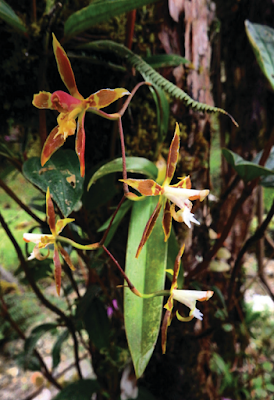Odontoglossum x luerorum is only reported from northwestern Ecuador where it occurs as an epiphyte at relatively high elevation cloud forest.
Odontoglossum x luerorum is a natural hybrid between Odontoglossum armatum and Odontoglossum mirandum. It was named in honor of Carlyle A. and Jane H. P. Luer of Sarasota, Florida, in gratitude for providing monumental amounts of ground-breaking orchid taxonomic knowledge and literature.
IDENTIFY ODONTOGLOSSUM X LUERORUM ORCHID PLANT
Odontoglossum x luerorum is only reported from northwestern Ecuador where it occurs as an epiphyte at relatively high elevation cloud forest. The type species is found in cloud forest above Maldonado west of Tulcan, at an altitude of 2000-2500 m.
It is a cool to cold epiphytic herb with caespitose, ovoid and longitudinally wrinkled with age, basally sparsely spotted with purple, unifoliate, ca. 3.5 x 1.2 cm pseudobulb surrounded basally by 5 to 6 distichous sheaths, the uppermost foliaceous that has 9 x 1.0-1.1 cm, narrowly elliptic and acute leaves.
This hybrid blooms from the erect to arching, 3-flowered inflorescence that carrying stellate flowers. Dorsal sepal yellow with brown spots and markings; lateral sepals similar in color; petals similar in color but with a white base; lip basally white then with a brown band, followed by a white band and a brown front lamina.
This natural hybrid is visually similar to both Odontoglossum armatum and Odontoglossum mirandum but differs by its intermediate features, such as having erect lateral lip lobes that are distinctly shorter for Odontoglossum mirandum, but distinctly longer than for Odontoglossum armatum, which basically lack erect lateral lip-lobes altogether and where the lip is fused to the column by lateral flanks only, as opposed to a short central longitudinal ridge (as for Odontoglossum mirandum), combined with lateral flank fusion for Odontoglossum x luerorum.
ODONTOGLOSSUM X LUERORUM ORCHID PLANT CARE AND CULTURE
Cultural information should only be used as a guide, and should be to be adapted to suit you. Your physical location; where you grow your plants, how much time you have to devote to their care, and many other factors, will need to be taken into account. Only then can you decide on the cultural methods that best suit you and your plants.
Light:
Odontoglossum x luerorum needs a light level of 10000-15000 lux for mature plants, but less for young plants and when temperatures are high (70% shade cloth over summer and more light in winter). Leaves turn reddish blue if receiving too much light and leaf loss will occur if too sun damaged. Dark green leaves indicate insufficient light. A slight bronzing of the leaves and older bulbs indicates the light is good for flowering.
Temperature:
This hybrid should be grown with a minimum nighttime temperature of 7 to 12°C, with daytime temperatures of 10 to 17°C. The diurnal difference between day and night is usually 8 - 10°C. In their natural environment night temperatures can fall to 5°C and although tolerant of low temperatures down to 0°C, they will not tolerate frosts.
Humidity:
This orchid prefer humidity levels between 55-75%; higher levels of 60-80% require good air movement especially in the cooler months. Plants can also tolerate humidity levels down to 40% which can be maintained or increased with morning and evening misting.
Substrate, growing media and repotting:
Odontoglossum x luerorum are usually grown in pot using small bark (5-10mm) perlite potting mix (5:1) or in sphagnum moss and perlite (70:30) as substrate. Some growers place a layer of sphagnum moss on the top of the pot to reduce evaporation and keep the roots cool. They can also be grown in perlite with a layer of gravel on the top.
These plants should be repotted every year to every 2 years in spring or autumn when new growths are about half mature. They should be grown in small squat pots that allow more frequent watering. The base of the new growth should be planted about 1.5cm into the bark but no deeper. Keep bark barely moist until new roots appear then resume normal watering.
Watering:
This orchid hybrid like abundant water and require frequent watering in warmer months. They must never be allowed to dry out. During summer irrigation will be required every 2 -3 days, however during winter rates may drop to once every 10 – 14 days. Misting daily in very hot weather is recommended. To reduce leaf spotting, avoid watering in the heat of the day or late afternoon in warmer months. Also avoid wetting the leaves and water the pot, not the leaves.
Fertilizer:
This plant require frequent application of half to quarter strength fertilizer all year round but less in winter. Apply fertilizer every 2 weeks when growing actively but monthly when less active. They are not gross feeders and too much fertilizer will harm their roots and turn leaf tips brown. Use of high phosphorus or potassium fertilizers as plants approach flowering can increase flower count and substance.
Rest period:
Odontoglossum x luerorum do not a rest period to stimulate flowering nor in winter. But they need less water in the winter, especially if they grow under the conditions of a dark, short day that occurs in moderate latitudes. You can let the plants dry between the next watering, but you must not let the plants stay dry for a long time. Fertilization should be limited or should be completely abandoned until spring, when stronger watering resumes.

















COMMENTS